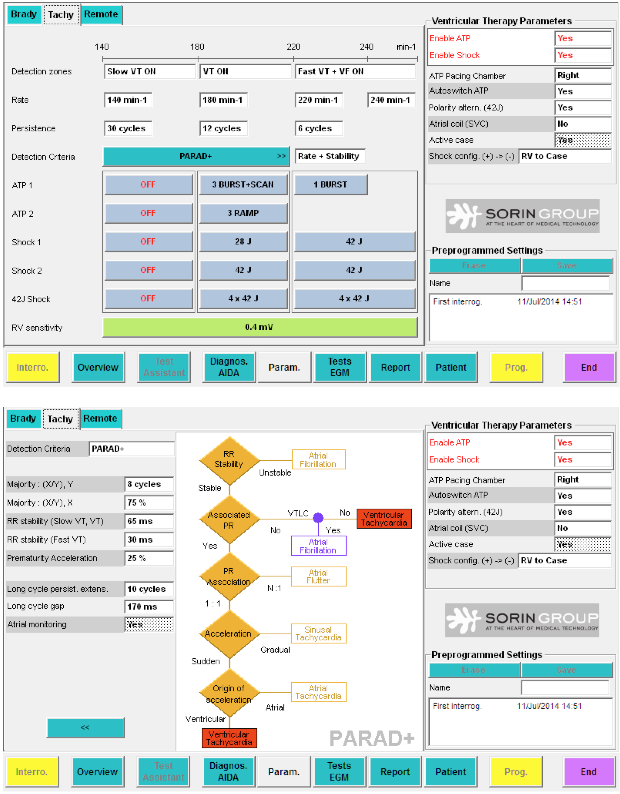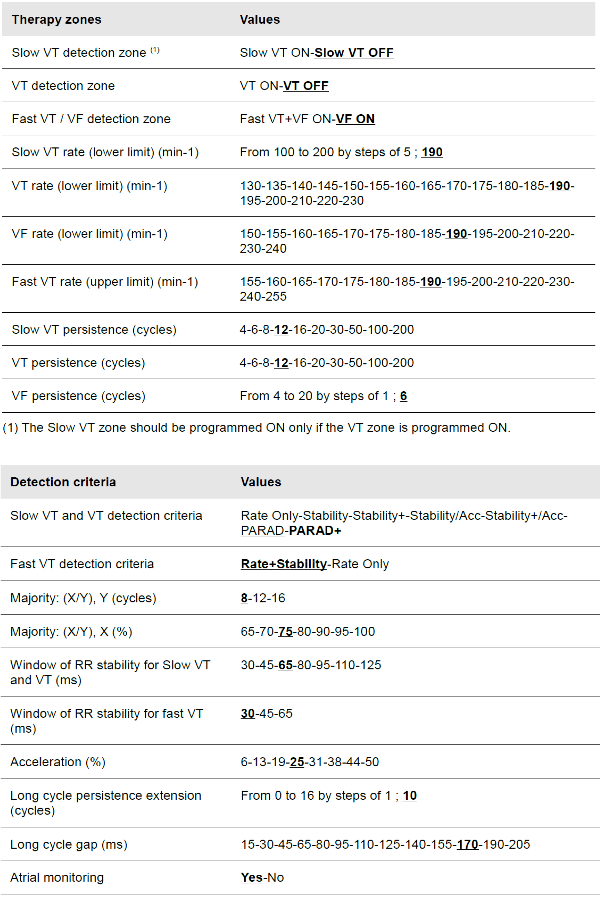Microport CRM-Sorin Discrimination
Specificities
1- SINGLE-LEAD DISCRIMINATION
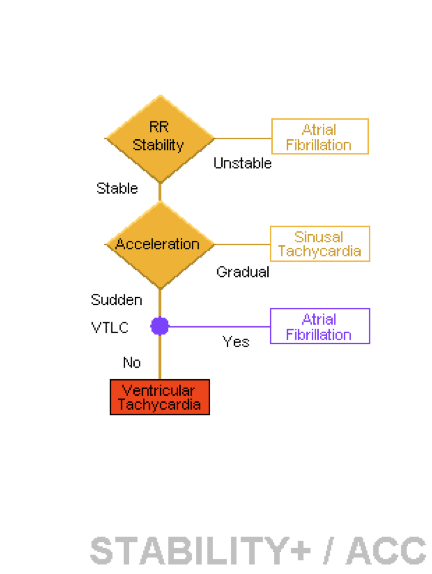
The defibrillator analyzes all ventricular events sensed in the detection zones. The device classifies each ventricular event according to cycle length and categorizes each majority rhythm as either:
- VF (ventricular fibrillation) or
- VT/VTLC, SVT/ST (tachycardia) or
- SR (slow rhythm) or
- No majority
If the rhythm is a tachycardia, three further criteria (RR stability, long cycle occurrence, sudden onset ) may be used to discriminate ventricular tachycardia from supraventricular or sinus tachycardia. After a VT or VF majority is reached and this majority persists for a programmable number of persistence cycles, ICD delivers the programmed ATP or loads the shock capacitors. ICD uses the tachycardia sorting template to classify rhythms with tachy majority. This sorting depends on RR stability (stable or unstable), VT Long Cycle occurrence (VTLC) and acceleration (sudden or gradual) at the tachycardia onset (ventricular origin or none).
The programmer provides predefined tachycardia detection criteria:
- Rate only: Use ventricular rate only.
- Stability: Use ventricular stability.
- Stability+: Use ventricular stability and search for a VT long cycle.
- Stability/Acceleration: Use ventricular stability and ventricular sudden onset.
- Stability+/Acceleration: Use ventricular stability, ventricular sudden onset and search for a VT long cycle.
Majority rhythm
The defibrillator applies the majority (X% of Y cycles) to determine the predominant rhythm:
- (X/Y) Y: number of cycles used by the device to analyze the ongoing rhythm.
- (X/Y) X: minimum percentage of cycles the device needs to classify the ongoing rhythm.

Unretained initial fast cycles
ICD excludes 2 cycles analysis at the beginning of the arrhythmia detection. The objective is to withdraw the unstable cycles often present at the beginning of the arrhythmia.
RR stability window for Slow VT and VT
When a rhythm is detected in the Slow VT zone or in the VT zone, the defibrillator counts the number of RR intervals within the programmed RR stability window width. The stability criterion is fulfilled when the number of those RR intervals is equal to at least X% of the cycles included in the detection zone.
Note: This parameter is not programmable if Detection criteria is programmed on Rate only.
RR stability window for Fast VT
When a rhythm is detected in the VF zone, at a mean rate between the Fast VT detection rate and VF detection rate, the defibrillator counts the number of RR intervals within the programmed RR stability window width. The stability criterion is fulfilled when the number of those RR intervals is equal to at least X% of the cycles included in the detection zone.
Note : This parameter is only programmable if the third detection zone is programmed Fast VT+VF on the Tachy screen.
Prematurity acceleration
This criterion attempts to distinguish pathological tachycardias from physiological ones by examining the onset of acceleration. The defibrillator defines an accelerated cycle when its cycle length is shorter than the reference cycle decreased by the programmed prematurity acceleration percentage, and when its cycle length is included in the Slow
VT and/or VT zone. The reference cycle is the mean of the last four non-accelerated cycles.
The defibrillator defines acceleration as ended as soon as it detects two consecutive cycles which are paced or not accelerated.
Note : Only programmable if Detection criteria is programmed on: Stability / Acc or Stability+ / Acc.
Long cycle occurrence
This criterion attempts to distinguish VT from atrial fibrillation (pseudo stable ventricular rhythms with long diastoles due to variable AV node conduction.
If the stability criterion is met, PARADYM RF VR 9250 searches for at least one long cycle (VTLC) over the 24 previous cycles.
VT therapy is inhibited as long as at least one VTLC is detected within the last 24 cycles.
- Long cycle persistence extension
Long cycle persistence extension is a programmable number of cycles added to the persistence in case of VTLC search. Persistence for other rhythm analysis remains the same.
Note : Only programmable if Detection criteria is programmed on: Stability+ or Stability+/Acceleration.
- Long cycle gap
A long VT cycle is defined as a cycle longer than the average of the last four cycles included in the VT zone plus a programmable interval: the long cycle gap. VTLC detection starts after the detection of four cycles classified as VT or VF.
Note : Only programmable if Detection criteria is programmed on: Stability+ or Stability+/Acceleration.
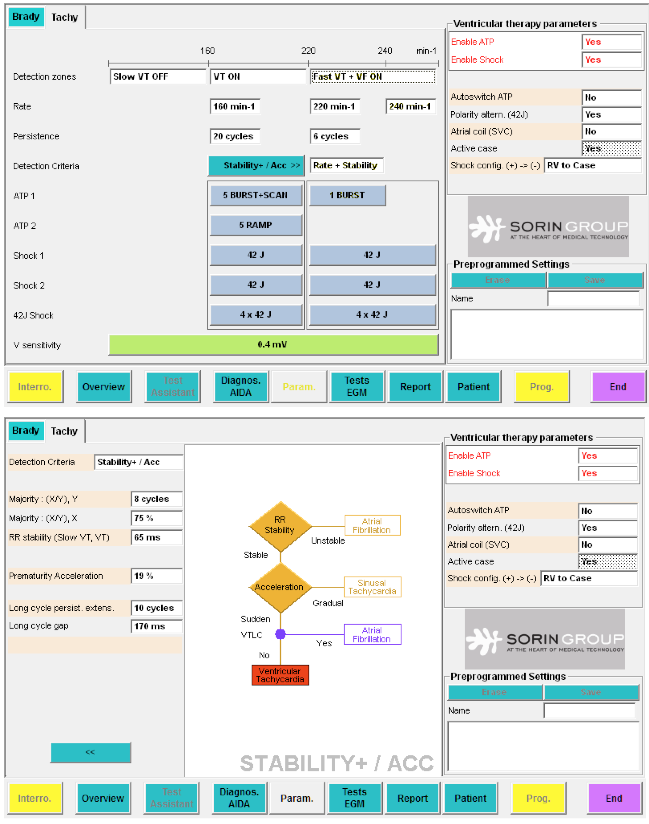
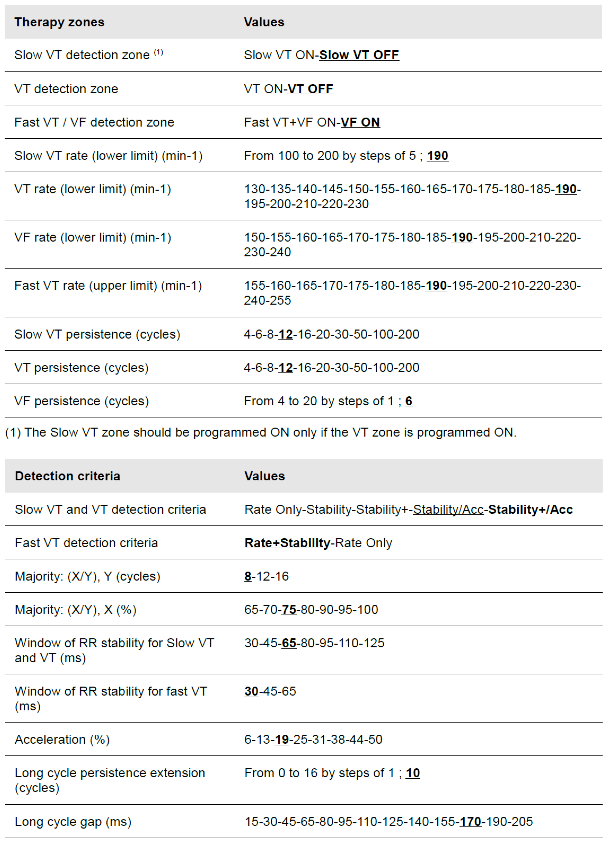
2 - DUAL-LEAD DISCRIMINATION
PARAD stands for “P And R based Arrhythmia Discrimination”. PARAD+ is an enhancement of the PARAD algorithm providing an additional criterion to further reduce the incidence of inappropriate therapy in patients presenting with episodes of atrial fibrillation.
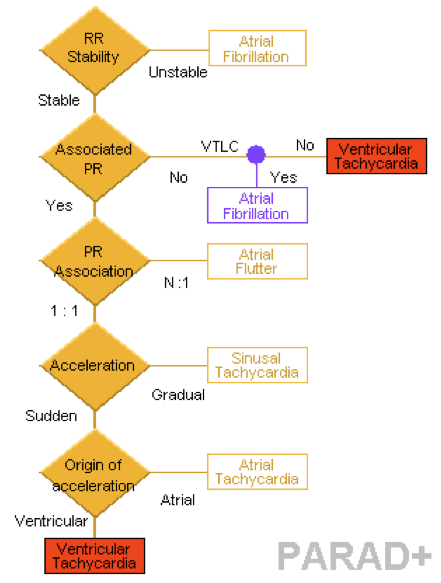
The defibrillator analyzes all atrial and ventricular events sensed in the detection zones. The device classifies each ventricular event according to cycle length and categorizes each majority rhythm as either:
- VF (ventricular fibrillation) or
- VT/VTLC, SVT/ST (tachycardia) or
- SR (slow rhythm) or
- No majority
If the rhythm is a tachycardia, five further criteria (RR stability, long cycle occurrence, PR association, sudden onset and chamber of origin of acceleration) may be used to discriminate ventricular tachycardia from supraventricular or sinus tachycardia. After a VT or VF majority is reached and this majority persists for a programmable number of persistence cycles, ICD delivers the programmed ATP or loads the shock capacitors.
ICD uses the tachycardia sorting template to classify rhythms with tachy majority. This sorting depends on RR stability (stable or unstable), PR association (N:1, 1:1, or none), VT Long Cycle occurrence (VTLC) and acceleration (sudden or gradual) at the tachycardia onset (atrial origin, ventricular origin or none).
The programmer provides predefined tachycardia detection criteria:
- Rate only: Use ventricular rate only.
- Stability: Use ventricular stability (ventricular sensing only).
- Stability+: Use ventricular stability and search for a VT long cycle (ventricular sensing only).
- Stability/Acceleration: Use ventricular stability and ventricular sudden onset (ventricular sensing only).
- Stability+/Acceleration: Use ventricular stability, ventricular sudden onset and search for a VT long cycle (ventricular sensing only).
- PARAD: Use ventricular stability, PR association, sudden onset and origin at onset (atrial and ventricular sensing).
- PARAD+: Use ventricular stability, search for a VT long cycle, PR association, sudden onset and origin at onset (atrial and ventricular sensing).
Note: PARAD/PARAD+ should not be used if there is no atrial lead or in case of insufficient atrial signal quality.
Majority rhythm
The defibrillator applies the majority (X% of Y cycles) to determine the predominant rhythm:
- (X/Y) Y: number of cycles used by the device to analyze the ongoing rhythm.
- (X/Y) X: minimum percentage of cycles the device needs to classify the ongoing rhythm.

Unretained initial fast cycles
ICD excludes 2 cycles from the PARAD/PARAD+ analysis at the beginning of the arrhythmia detection. The objective is to withdraw the unstable cycles often present at the beginning of the arrhythmia.
RR stability window for Slow VT and VT
When a rhythm is detected in the Slow VT zone or in the VT zone, the defibrillator counts the number of RR intervals within the programmed RR stability window width. The stability criterion is fulfilled when the number of those RR intervals is equal to at least X% of the cycles included in the detection zone.
If the RR stability criterion is met, the defibrillator counts its PR intervals within a 65 ms stability window. It finds PR association when this number of stable PR intervals is at least X% of the number of stable RR intervals. In addition, if the number of PR intervals represents at least X% of the total PR cycles, the defibrillator considers this as 1:1 PR association. Otherwise, it considers this as a N:1 association.
Note: This parameter is not programmable if
Detection criteria is programmed on Rate only.
PR Association
If the RR stability criterion is met, ICD scans its PR interval histogram with a window set to the PR association, window width (equal to RR stability window), looking for the window position which contains the maximum number of PR intervals. It finds PR association when this number is at least X% of the number of stable RR intervals. In addition, if the number of PR intervals within this window represents at least X% of the PR cycles stored in the histogram, ICD considers this as a 1:1 PR association; otherwise it considers this as a N:1 association.
RR stability window for Fast VT
When a rhythm is detected in the VF zone, at a mean rate between the Fast VT detection rate and VF detection rate, the defibrillator counts the number of RR intervals within the programmed RR stability window width. The stability criterion is fulfilled when the number of those RR intervals is equal to at least X% of the cycles included in the detection zone.
Note: This parameter is only programmable if the third detection zone is programmed Fast VT+VF on the Tachy screen.
Prematurity acceleration
This criterion attempts to distinguish pathological tachycardias from physiological ones by examining the onset of acceleration. The defibrillator defines an accelerated cycle when its cycle length is shorter than the reference cycle decreased by the programmed prematurity acceleration percentage, and when its cycle length is included in the Slow VT and/or VT zone. The reference cycle is the preceding ventricular interval except in some cases: asynchronous beats, pause or accelerated cycles. In these cases the reference cycle is the mean of the last four non-accelerated cycles.
When pacing mode is DDD, there is atrial acceleration when the first accelerated cycle and the preceding one are conducted; that is preceded by an atrial event within the range from 31 to 313. If one or two of these two beats is not conducted, the acceleration is defined as ventricular.
When pacing mode is SafeR, there is atrial acceleration when a ventricle is considered as conducted if :
- there is an atrial event in the ventricular cycle or
- the RR interval and PP interval have around the same length very (RR > 75% PP).
In all other cases, acceleration is set to ventricular.
The defibrillator defines acceleration as ended as soon as it detects two consecutive cycles which are paced or not accelerated.
Note: Only programmable if Detection criteria is programmed on: Stability / Acc or Stability+ / Accor PARAD or PARAD+.
Long cycle occurrence
This criterion attempts to distinguish VT from atrial fibrillation (pseudo stable ventricular rhythms with long diastoles due to variable AV node conduction and therefore no PR association).
If the stability criterion is met and there is no PR association, ICD searches for at least one long cycle (VTLC) over the 24 previous cycles.
VT therapy is inhibited as long as at least one VTLC is detected within the last 24 cycles.
- Long cycle persistence extension
Long cycle persistence extension is a programmable number of cycles added to the persistence in case of VTLC search. Persistence for other rhythm analysis remains the same.
Note: Only programmable if Detection criteria is programmed on: Stability+ or Stability+/Acceleration or PARAD+.
- Long cycle gap
A long VT cycle is defined as a cycle longer than the average of the last four cycles included in the VT zone plus a programmable interval: the long cycle gap. VTLC detection starts after the detection of four cycles classified as VT or VF.
Note: Only programmable if Detection criteria is programmed on: Stability+ or Stability+/Acceleration or PARAD+.
- Atrial monitoring
The defibrillator normally turns off atrial sensing when programmed to VVI mode and when programmed with a tachycardia sorting template which does not require atrial sensing. Atrial sensing markers no longer appear during real-time telemetry or in the Holter records. When atrial monitoring is programmed to Yes, the defibrillator enables atrial sensing markers regardless of programming.
This parameter must be programmed to No if there is no atrial lead.
Note: Only programmable if Detection criteria is
programmed on Rate only or Stability or Stability/Acceleration or Stability+ or Stability+/Acceleration.
